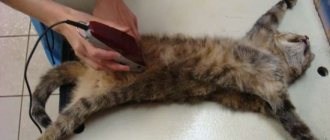Ear diseases in cats can be non-contagious or contagious in origin.
The most common non-contagious ear diseases in cats include:
- Inflammation of the middle and inner ear - otitis media.
- Inflammation of the external ear is an inflammation of the skin of the auricle and external auditory canal.
- Hematoma is an accumulation of blood under the skin of the ear.
- Lymphoextravasate is an accumulation of lymph under the skin of the auricle.
- Auricular necrosis is the death of the ear cartilage.
- Foreign bodies in the ear canal.
- Neoplasms.
Ear hematoma in cats
Hematoma in cats occurs as a result of mechanical damage to the auricle - blows, bites from other cats, insects, scratching.
With a hematoma, blood flows from the blood vessels of the auricle into the tissue under significant pressure, pushing these tissues apart and forming a cavity. The size of the hematoma depends on the strength of blood pressure in the damaged vessel, as well as on the degree of compliance of the tissues located near it.
A hematoma occurs quickly and its volume increases until the pressure from the stretched tissue becomes equal to the pressure in the damaged blood vessel. After this, the spilled blood clots, and a blood clot forms in the blood vessel.
Most often, hematomas in cats occur on the inner surface of the ear and much less often on the outside. The damaged ear increases in size, hangs down, and the swelling is painful and hot to the touch. If the hematoma is not treated, the pain only increases, and the hematoma itself can become infected with secondary microflora, which can ultimately lead to necrosis of the ear cartilage.
During a clinical examination of such a cat, a veterinarian notes the following symptoms:
- We observe anxiety and nervousness in the cat.
- The cat almost constantly shakes its head from side to side.
- He constantly scratches his damaged ear with his paws.
- When trying to stroke the cat's head, it becomes aggressive.
Treatment. Treatment of auricular hematoma is not very difficult. If no more than 48 hours have passed since the formation of the ear hematoma, then the cat owner fixes the ears with a bandage on the back of the head and applies cold. In the future, in order to resolve the hematoma, it is necessary to use heat and apply locally irritating ointments.
If the hematoma cannot be cured at home, the owner needs to contact the nearest veterinary clinic. In a veterinary clinic, the veterinarian will open the resulting hematoma, remove blood clots from it, wash the resulting cavity with a solution of novocaine with antibiotics and give recommendations to the owner so that the hematoma resolves safely.
Treatment
Treatment of sores on the ears and face of a cat requires an integrated approach based on research results. Depending on the type of pathological process and the cause that caused it, the veterinarian develops an individual scheme.
Crusts and ulcers formed on the ears and face as a result of an allergic reaction should be treated by eliminating the provoking factor. So, in case of nutritional allergies caused by improper feed or products, a replacement diet is carried out. The specialist selects the food and observes the body’s reaction.
If the cause of the allergy is contact with household chemicals, it is necessary to eliminate the allergen from everyday life. As a rule, after eliminating the underlying factor of the allergy, the body copes on its own and the skin is restored.
The addition of pathogenic bacterial microflora implies the use of antibiotics. The duration of the course and the type of drug are selected by the doctor, taking into account the patient’s age, weight and body characteristics.
Treating ulcers on a cat’s face and ears is quite problematic, since the animal often licks external medications (ointments and liniments) that are applied to disinfect wounds and eliminate pathogenic microflora. During the entire course of therapy, the owner is recommended to purchase a special collar to put on the animal so that it does not reach the treated areas. If your cat feels discomfort and refuses to eat with the collar around its neck, you can remove it while eating.
The resulting sores on the skin, provoked by subcutaneous mites (sarcoptosis or demodicosis), are treated comprehensively. In addition to specific medications, therapy necessarily includes taking immunomodulating agents and vitamin complexes. This is due to the fact that with a normal level of immunity, the animal’s body is able to cope with the disease on its own.
Lymphatic extravasation of the auricle in cats
Lymphatic extravasation is an accumulation of lymph in a cavity formed as a result of tissue dissection and rupture of lymphatic vessels.
Lymphatic extravasation of the auricle in a cat occurs for the same reasons as a hematoma.
It develops slowly in a cat and is characterized by the development of a contouring swelling in the ear area; there is no local increase in temperature.
The diagnosis is made by clinical signs. To clarify the diagnosis, a puncture of the resulting swelling is performed.
Treatment. With this disease, unlike a hematoma, it is strictly forbidden to use cold or heat. In case of this disease, the owner must contact a veterinary clinic. Where the drained lymph will be aspirated using a syringe. If this procedure does not lead to the desired results, then the veterinarian resorts to surgery, which boils down to making a skin incision and more thoroughly removing the contents of the cavity and applying small sutures.
Causes of crusts on a cat's ears
The crusts that form on the soft tissues of the animal usually consist of dead particles of the dermis, dried ichor or pus, and coagulated blood. In color they can be brown, yellow-gray, brown. Let's consider the possible causes of the pathological condition.
Parasites (fleas, ticks)
Blood-sucking insects often accumulate on areas of the body that are most difficult for an animal to reach - on the withers, in the ear area, on the neck. The bites cause itching, inflammation and minor bruising. The cat will scratch the skin, after which traces will remain in the form of dried crusts.
Otodectosis is an ear mite that infects cats, dogs and many other animals. It penetrates deep into the soft tissues of the auditory organs and parasitizes there. A sign of otodectosis is dark crusts in the ears. May be observed: redness, ichor, swelling. If the pet is not treated, the tick leads to severe inflammation and deafness.
The otodeca mite is microscopic and invisible to the human eye. The only symptoms that indicate its parasitism are crusts on the cat’s ears. To confirm the diagnosis, it is necessary to undergo a test. To get rid of otodectosis, drops and special preparations for washing the ears are prescribed.
Allergy
Allergic reactions in a pet can occur to anything - food, dust, household chemicals used in the house, litter tray, etc. Allergic dermatitis appears most often on soft tissues and where the skin is the most delicate and thin. The affected areas become covered with spots, rashes, blisters, and crusts later form in their place. The allergy is accompanied by itching and the cat will scratch the rash.
When an allergy is diagnosed, antihistamines are prescribed. To eliminate external symptoms, ointments and tinctures are used for rubbing. It is very important to remove the allergen immediately, otherwise the treatment will be temporary.
Fungal infections (mycoses)
This group includes various lichens and dermatomycoses caused by fungal microorganisms. Some of them are transmitted to people. If a cat has crusts on the tips of the ears, in the shell itself, next to the ear, this is a sign of lichen. Associated symptoms of fungal infections: hair loss, peeling, suppuration or bleeding from affected areas, unpleasant odor. The discharge gradually dries out and forms sores and crusts.
For the treatment of dermatomycosis, fungicidal preparations are used in the form of ointments, liquids, drops. The animal may also be prescribed antifungal medications to take orally. With timely treatment, the prognosis is favorable - the pet recovers quickly and hearing loss does not occur.
In domestic cats that go outside, frostbite and hematomas are the cause of the formation of crusts. A cat's ears are not protected by a lot of fur, and their cartilage is very thin - they quickly freeze in extreme cold. The dead tissue gradually begins to peel off, but first a crust appears.
Having discovered painful signs on your pet’s ears, it is better not to guess about the reasons, but to immediately seek qualified advice.
Necrosis of the auricle
Necrosis of the auricle in a cat can occur as a result of:
- Transfer of purulent processes from surrounding tissues to the auricle.
- With prolonged squeezing of the auricle.
- Infection of hematomas, lymphatic extravasates with pathogenic microflora and with an abscess in the ear area.
When a purulent process develops in the area of the auricle and in the absence of proper and necessary treatment, the resulting abscess opens, forming areas of skin necrosis (necrosis), resulting in ulcers appearing on the auricle.
During a clinical examination, the ear cartilage begins to be visible through the areas of damage, and its blood circulation is disrupted. The cartilage itself becomes black in color and emits an unpleasant putrid odor. With necrosis, the cartilage tissue rots, and the ear becomes deformed.
Treatment. Treatment of auricular necrosis should be carried out in a veterinary clinic. A veterinary specialist performs either a complete amputation of the auricle or a necrotic part of it, followed by a course of treatment with antibiotics.
Symptoms
The symptoms of ear diseases in cats, the intensity, severity of clinical manifestations depend on the form, stage of a particular disease, on the general condition, resistance of the body, and the age of the animals.
Otodectosis
The main symptoms of ear diseases in cats:
- deterioration of general condition;
- increase in general, local temperature;
- refusal to feed, loss of appetite;
- severe ear itching;
- unpleasant, specific smell from the ears;
- the presence of crusts, scabs, ulcers on the inner surface of the ears;
- the skin is hyperemic, irritated;
- pain on palpation;
- scratches, wounds, sores on the outer surface of the ears;
- enlargement of regional lymph nodes.
Cats may show anxiety and react inappropriately to external stimuli. Animals, experiencing severe itching, constantly rub their paws on the damaged ear, shake their heads, and experience discomfort and pain. not allowing anyone to touch the sore ear. When examining the ears, you can see a large amount of dark brown sticky, foul-smelling mass inside the ear canal.
With hematomas on the affected ear, you may notice a swelling that causes severe pain and discomfort upon palpation. As a rule, cats paw at the damaged ear and feel anxious. If measures are not taken and the hematoma is not treated, this can lead to deformation of the auricle, tissue necrosis, and an abscess.
Hematoma
Since otodectosis is caused by microscopic parasites, it is impossible to notice them with the naked eye. The development of ear scabies may be indicated by a change in the behavior of a pet, an unpleasant odor from the ears, or the presence of a large amount of sticky dark brown plaque, which is formed during the life of a dangerous mite. The development of allergic reactions and deterioration in the general condition of animals is possible.
With otitis, inflammation of the middle and inner ear, pus accumulates in the ear canal, an unpleasant odor is heard from the ears, and a characteristic squelching sound appears when you press on the sore ear.
Signs of otitis include: increased general temperature, lethargy, apathy, drowsiness. Possible attacks of vomiting, nausea, and loss of coordination of movements. Cats lower their heads on the side of the affected ear and do not allow them to touch the auricle. If not treated promptly, the eardrum may rupture, leading to loss of hearing function.
Foreign body in the external auditory canal
Foreign bodies can get parts of plants, insect larvae, sand, lice into the ear canal, wax plugs and other objects can form.
Sometimes the presence of a foreign body in a cat’s ear does not cause any concern and may go unnoticed by the animal’s owners. Most often, a foreign body causes irritation and inflammation in the external auditory canal.
Treatment. Treatment should be aimed at removing the foreign body from the ear. After removing it, the ear canal is washed with a solution of soda or a 3% solution of hydrogen peroxide. In order to reduce the cat's pain reaction, it is necessary to drop a few drops of camphor oil into the ear canal.
Prevention
To prevent the development of ear diseases in cats, owners must systematically examine their pet’s ears and clean the ears from excess wax and plaque. To carry out hygienic procedures, you can use special preventive solutions, hydrogen peroxide. You should not treat your cat’s ears with alcohol solutions, much less instill medicinal or hormonal medications for preventive purposes. The procedure should be carried out only with sterile gauze and cotton pads and ear sticks. Use a separate blank disk for each ear.
Ear cleaning
Avoid hypothermia or prolonged exposure of animals to drafts. When bathing your pet, to prevent water from getting into the ears, you can purchase special ear swabs or close the ear canal with a cotton pad. After swimming, check to see if any water has entered the ear.
Cat scratching its ear
In addition, you need to pay attention to the state of the immune system, introduce multivitamin, mineral complexes and supplements into the diet. If the general condition worsens and you notice the above symptoms of ear diseases, take your cat to a veterinarian.
We invite you to join our Zen channel and group on VKontakte or Odnoklassniki, where new articles for pet owners are published.
Similar articles:
- If your cat has food allergies
- Ringworm Caution: What Pet Owners Need to Know
- Why are cats overweight?
Neoplasms in the external auditory canal
In cats, the most common neoplasms in the external auditory canal are sarcoma, fibroma and papilloma. As they grow, they cause the cat to become deaf.
If a cat has neoplasms, the main signs are:
- The cat's head is lowered towards the affected ear.
- We note uncoordinated and manege movements in the cat.
Treatment. Treatment of tumors in the external auditory canal is only surgical, which must be carried out in a veterinary clinic.
Diagnostic procedures
A complete examination of your pet, for which you need to donate blood for analysis, will help you make a diagnosis.
A tumor on a cat’s ear requires contacting a veterinarian, since it can pose a danger not only to the health, but also to the life of the animal. First, the specialist examines the damaged area of the pet and asks the owner about possible injuries and mechanical damage. To make a final diagnosis and select treatment, the following diagnostic procedures are performed:
- blood and urine tests;
- laboratory examination of ear discharge;
- biopsy to determine the nature of the tumor.
Dermatitis and eczema of the ears
With dermatitis, the cat's ear turns red and a rash appears on the skin. A sick cat begins to scratch its ears due to severe itching, increasing the symptoms of dermatitis. With dermatitis, hair begins to fall out from the damaged area of the skin. Food allergies cause dermatitis in cats. Streptococcosis (Streptococcosis of dogs and cats) can lead to dermatitis.
Parasitic otitis.
Parasitic otitis in cats occurs with otodectosis and notoedrosis (Otodectosis in cats, notoedrosis (pruritic scabies).
How to diagnose
Only a doctor can diagnose a disease and determine how to treat it. The owner is unable to see problems in the inner ear or diagnose the severity of the disease.
Diagnostics
For diagnosis, veterinarians use different techniques:
- Primary examination: examination of the outer ear for injuries, swelling, redness;
- Examination using an otoscope;
- A test to determine the composition of the fluid secreted from the ear.
Information sheet! Usually this is enough to identify the disease. Sometimes a CT scan, x-ray, or neurological tests may be required.
After diagnosis, the doctor will be able to tell exactly why the cat’s ear hurts and what can be used to instill it.
Tumors
Presumably polyp.
Cats develop benign and malignant tumors. Under certain circumstances, a harmless growth degenerates into an oncological tumor.
Most often, this development of events occurs when the cat owner decides to fix the problem on his own. Therefore, if you find a lump on or near the ear, you should seek veterinary help. Polyps occur in the ears of young or mature animals.
Even when the tumor does not hurt, it must be removed, as conditions arise for otitis media - inflammation of the ear. The enlarged formation blocks the ear canal and can lead to deafness. In any case, a sample is taken for histological examination. If the oncological nature of the disease is confirmed, radiotherapy or chemotherapy methods are used.
Mastocytoma
Malignant tumors - mastocytomas form in older pets. At the initial stage, the lump looks harmless. However, as the tumor matures, cells in its center die. Necrotic tissue falls off and ulcers form.
Treatment is surgical - in addition to the tumor itself, up to 3 cm of surrounding tissue is removed, up to the amputation of the shell. A course of chemotherapy or radiotherapy is carried out, followed by rehabilitation and lifelong dietary nutrition.
Be sure to read:
The cat has a fever: what to do, reasons, what is the norm, how to bring it down at home, the best methods











